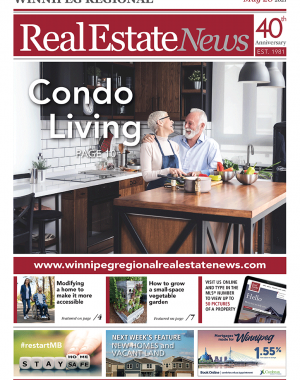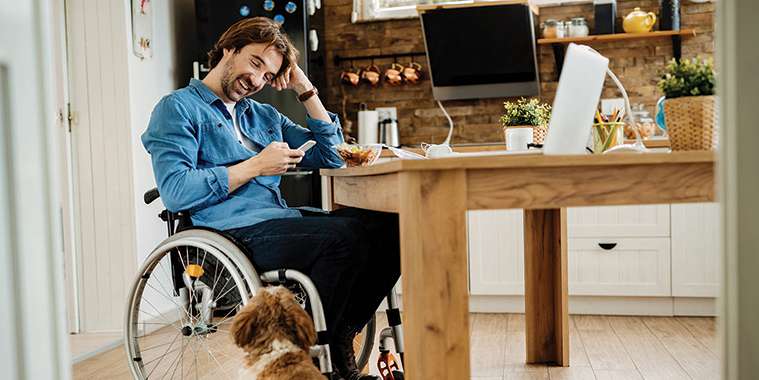National AccessAbility Week (NAAW) is from May 30 to June 5. This is an opporunity to celebrate the valuable contributions of Canadians with disabilities and to recognize the efforts of individuals, communities and workplaces that are actively working to remove barriers to accessibility and inclusion.
We all benefit from a society and an economy without barriers to inclusion. Nowhere is that more important than within one’s home.
While it’s easy to think that a physical disability is something that only would happen to someone else, the truth is that disability can occur to any person at any time — whether from an accident or a condition like cancer or just the natural aging process. And many times people find that their home requires disability modifications in order for them to return there after a hospital stay or to allow them to live there comfortably for the long term.
There are as many ways to make your home handicap accessible as there are types of disabilities. Here are some of the general things to think about when tackling home remodelling for the disabled, particularly someone who’s in a wheelchair. They also come in handy should you choose to buy a new home that already features barrier-free design.
Eliminate or modify steps
Sometimes the first barrier a disabled person encounters is getting into the house at all. If you have steps to your front door, see if there’s an alternate entry that a disabled person can use, such as through the garage or back door. Otherwise, you’ll need to create a ramp or other way that a wheelchair can roll into the home.
Make sure you have access to a first-floor bathroom and bedroom
In today’s modern two-story houses, often most of the actual “living” areas — that is, where you sleep and use the bathroom — are upstairs. If you have someone in your home who’s disabled, you’ll need to either move to a one-story home or add in a bathroom and bedroom downstairs to eliminate the need for stairs.
Create wider doorways and hallways
Expanding your doorways and hallways may be necessary to make your home wheelchair accessible; ideally doorways should be at least 36 inches wide. While you’re at it, check your flooring to ensure that it is smooth to allow for easier traversing; replace carpet with linoleum, wood or tile. Remove throw rugs or hall liners so they don’t “grab” wheelchairs or walkers. Removing rugs is a smart solution anyway as they can be dangerous, contributing to slips and falls for someone with limited mobility.
Retrofit the bathroom
The bathroom can be the most challenging room of the house to make handicap accessible, but it is possible. First, install grab bars near the toilet area to ease the person transferring from the wheelchair to the toilet. Then add a roll-in shower — or one that otherwise has a low lip which doesn’t require a huge step to enter — along with another set of graspable handles.
Ensure adequate lighting
Low lighting can create a hazard for anyone in a home, but particularly someone who is disabled. Make sure that you have strong overhead lights that they can turn on with just the flip of a switch – or even better, with voice-activated commands.
Take into account all the obstacles
As you move about the house, anticipate what areas might be challenging for a wheelchair to maneuver, whether it’s a coffee table that blocks a path or a cupboard that’s too high to be easily reached. Determine what things are OK to leave as-is with some changes – perhaps you only move some of the kitchen items to lower, more accessible shelves – and which need to be addressed with retrofits or other modifications.
Funding to help modify a home
Listed here are some provincial and federal government programs to assist homeowners with the necessary modifications to make their home more accessible.
• Residential Adaptation for Disabilities Program
Manitoba offers this program that provides up to $16,000 ($19,000 for remote areas). It is available to people with low income to help pay for adaptations to their home that help increase mobility, safety, and independence for people with disabilities. This forgivable loan does not have to be paid back as long as you live in the home for 5 years after the adaptions are completed.
Eligible adaptations include handrails, storage areas, grab bars, wheelchair ramps, entryways and interior doors, lift systems, floor covering, plumbing and electrical. Eligibility:
• Primary home is in Manitoba (outside First Nation Community)
• Gross income is less than the level set by Manitoba Housing for the community
• Someone in home has a disability
• Landlord that rents a unit below the affordable rent amount for the area
• Home’s BC Assessment value is below the Home Value Limit.
• Residential Access Modification Program (RAMP)
RAMP provides a grant of up to $7,500 with an option for multiple grants of up to $15,000 in a 10-year period. This program is available to people with disabilities who earn a low income to help pay for modifications to their home to increase accessibility.
Eligibility requirements:
• Must use a wheelchair, a four-wheel walker, or have a neurodegenerative disease
• Household income under $36,000 (amount increases per couple, and if a child under 21 years who lives in the house uses a wheelchair or attends school full time)
• Modifications enable the wheelchair user to access or move within their living space.
Includes previous and future modification.
• Federal/Provincial Repair Program
This is a program funded by both the federal and provincial governments and provides a forgivable loan of up to $10,000 for regular repairs and $10,000 for disabled accessibility items.
It is available to seniors and homeowners with a disability who earn a low income to help pay for repairs to their home that increase accessibility and safety. The amount the loan given is based on income and the amount of repairs needed. Landlords also qualify up to a maximum of $10,000.
Eligible adaptations:
• Household income less than the established housing income limits
• Own and reside the home
• Home requires major repairs or lacks basic facilities
• Modifications are housing-related and/or provide better access within the home
• Modifications facilitate and prolong independent living.
There are many ways to modify a home to make it more accessible. Do your research to find out about all available funding and options.



